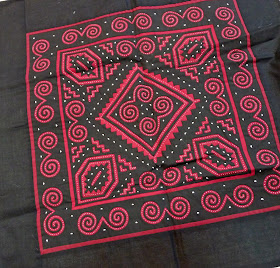First, I want to let you know that the pieces shown today are NOT my work, but pieces I have collected over the many years that I have been under the spell of hand crafted textiles.
This is a hand stitched piece in the Hmong tradition (cudos to you, Suz!). You can read more about Hmong handwork and culture here. I suspect that this piece was sewn to sell and is fairly newly made. I bought it at a quilt show.
(detail)
The stitches in this piece are so tiny they are nearly invisible, and the precision of the design is quite remarkable.
This piece is a relatively old mola, most likely stitched in Central America. (Did you know that Batman grew up in Latin America, and has an appreciation of these beauties!)
(detail)
These stitches are a bit more rustic, and look at all those layers of color!
Reverse applique is done by layering several fabrics, then cutting away bits of it, turning the raw edges under to expose what's underneath and then stitching the edges carefully, to hold them in place. For a tutorial on "how to", click here.
I took the idea of reverse applique and added some very simple embroidery stitching to get this more simple and modern look. (It became a tea towel).
One of my fascinations with hand stitched textiles is the way they are so often related to one another, across time and continents and cultures. The Hmong tribes in Asia and the Cunas of Central America each created distinct yet similar techniques to tell their stories. I think that's quite magical.





oh wow, I don't think I have ever seen it before, that last peice is gorgeous!
ReplyDeletexxx
We saw these all over Panama when we were there a few years ago, both rough "for the tourist trade" sewn and fine. Beautiful!
ReplyDelete